Hygrothermal Performance of Salt (NaCl) for Internal Surface Applications in the Building Envelope
Abstract
1. Introduction
2. Materials and Methods
2.1. Hygrothermal Simulation
2.1.1. Objective
2.1.2. External Condition—Climate Parameters
2.1.3. Internal Conditions—Indoor Parameters
2.1.4. Boundary Condition—Exterior Wall
2.2. Experimental Measurements
2.2.1. Objective
2.2.2. The Testing Room
2.2.3. The Test Materials
2.2.4. The Test Instrumentation
2.2.5. The Test Protocol
3. Results
3.1. Simulation WUFI®Pro
3.2. Simulation WUFI®Plus—Influence on the Indoor Air Quality and Energy Consumption
3.3. Measurements
4. Discussion
4.1. Temperature
4.2. Humidity and Water Content
4.3. Influence on the Indoor Air Quality without HVAC for Enclosed Spaces
4.4. Influence on the Energy Consumption with HVAC for Enclosed Spaces
4.5. Suggestions for Future Studies
- -
- Salt mixtures with other materials for increasing resource efficiency and saving of CO2: The annual world production of cement is about 4.4 billion tons [66], of gypsum 150 million tons [67,68,69], and 1.1 billion tons of salt [70,71,72,73] is produced each around the world. The production of cement and gypsum is subject to substantial criticism because of its high energy demand [74,75] and the heavy impact of mining on landscapes [15,17,76,77,78]. Resources such as FGD gypsum, which currently supply approx. 50.0% of the gypsum requirement in Germany [69], is disappearing due to German energy strategies (the phasing out of coal combustion) [79,80]. By increasing the salt content in the composite material, natural resources (e.g., natural gypsum) will be protected, less energy will be needed for production and CO2 emissions will be reduced. Each ton of cement replaced by one ton of salt would save approximately 600 kg of CO2 [81] emissions.
- -
- Hygrothermal performance of other salt composites: The simulated and on-site measurements of different salt composites (salt and concrete, salt and gypsum, salt and clay) should be analysed in detail, comparing and evaluating the passive regulation of indoor temperature and relative humidity in different climate conditions. The inclusion of other additives should also be considered for more effective heat and moisture transport.
- -
- Durability of salt materials: Salt materials should be exposed to different humidity, temperature and different positions in the thermal envelope to investigate degradation, aging, and durability. Measured results should be compared with simulations.
- -
- Other constructive possibilities: In this research was salt analysed only as a cladding element. Different constructive possibilities, such as supporting components in 3D printing, modular prefabricated elements, or just filling material for interior walls, should be further considered and explored.
5. Conclusions
Author Contributions
Funding
Institutional Review Board Statement
Informed Consent Statement
Acknowledgments
Conflicts of Interest
References
- Künzel, H.M.; Karagiozis, A. 2-Hygrothermal behaviour and simulation in buildings. In Materials for Energy Efficiency and Thermal Comfort in Buildings; Hall, M.R., Ed.; Woodhead Publishing: Sawston, UK, 2010; pp. 54–76. [Google Scholar]
- Künzel, H.M. Simultaneous Heat and Moisture Transport in Building Components: One- and Two-Dimensional Calculation Using Simple Parameters; IRB: Stuttgart, Germany, 1995. [Google Scholar]
- Künzel, H.M.; Holm, A.; Zirkelbach, D.; Karagiozis, A.N. Simulation of indoor temperature and humidity conditions including hygrothermal interactions with the building envelope. Sol. Energy 2005, 78, 554–561. [Google Scholar] [CrossRef]
- Kong, F.; Wang, H. Heat and mass coupled transfer combined with freezing process in building materials: Modeling and experimental verification. Energy Build. 2011, 43, 2850–2859. [Google Scholar] [CrossRef]
- Viitanen, H.; Krus, M.; Ojanen, T.; Eitner, V.; Zirkelbach, D. Mold Risk Classification Based on Comparative Evaluation of Two Established Growth Models. Energy Procedia 2015, 78, 1425–1430. [Google Scholar] [CrossRef]
- Bjarløv, S.P.; Finken, G.R.; Odgaard, T. Retrofit with Interior Insulation on Solid Masonry Walls in Cool Temperate Climates—An Evaluation of the influence of Interior Insulation Materials on Moisture Condition in the Building Envelope. Energy Procedia 2015, 78, 1461–1466. [Google Scholar] [CrossRef]
- Holl, K.K. Der Einfluss von Klimaschwankungen auf Kunstwerke im Historischen Kontext: Untersuchung des Schadensrisikos Anhand von Restauratorischer Zustandsbewertung. Ph.D. Thesis, Otto-Friedrich-Universität Bamberg, München, Germany, 2016. [Google Scholar]
- Pungercar, V.; Musso, F.; Dinkel, A.; Coydon, F.; Pflug, T.; Höfert, L.; Liedloff, F.; Krauße, A. Fenstermaschine II: Vorgefertigte Sanierfenster Mit Integrierter Technik—Demoprojekt; Fraunhofer IRB: Stuttgart, Germany, 2018. [Google Scholar]
- Pungercar, V.; Zhan, Q.; Xiao, Y.; Musso, F.; Dinkel, A.; Pflug, T. A new retrofitting strategy for the improvement of indoor environment quality and energy efficiency in residential buildings in temperate climate using prefabricated elements. Energy Build. 2021, 241, 110951. [Google Scholar] [CrossRef]
- United Nations. World Population Prospects 2019: Data Booklet; United Nations: New York, NY, USA, 2019. [Google Scholar]
- Earth Overshoot Day, Country´s Overshoot Day in 2019. 2019. Available online: https://www.overshootday.org/newsroom/country-overshoot-days/ (accessed on 15 December 2019).
- Commission of the European Communities, Thematic Strategy on the Sustainable Use of Natural Resources. 2005. Available online: https://eur-lex.europa.eu/legal-content/EN/TXT/PDF/?uri=CELEX:52005DC0670&from=en (accessed on 13 December 2019).
- Jones, E.; Qadir, M.; van Vliet, M.T.H.; Smakhtin, V.; Kang, S.-M. The state of desalination and brine production: A global outlook. Sci. Total Environ. 2019, 657, 1343–1356. [Google Scholar] [CrossRef]
- International Fertilizer Industry Association, Potash Case Study. Available online: https://pubs.iied.org/g00557 (accessed on 10 December 2021).
- Braukmann, U.; Böhme, D. Salt pollution of the middle and lower sections of the river Werra (Germany) and its impact on benthic macroinvertebrates. Limnologica 2011, 41, 113–124. [Google Scholar] [CrossRef]
- Hoepner, T.; Lattemann, S. Chemical impacts from seawater desalination plants—A case study of the northern Red Sea. Desalination 2003, 152, 133–140. [Google Scholar] [CrossRef]
- Palomar, P.; Losada, I.J. Impacts of Brine Discharge on the Marine Environment: Modelling as a Predictive Tool. In Desalination, Trends and Technologies; IntechOpen: London, UK, 2011; pp. 279–310. [Google Scholar] [CrossRef]
- Reta, G.; Dong, X.; Li, Z.; Su, B.; Hu, X.; Bo, H.; Yu, D.; Wan, H.; Liu, J.; Li, Y.; et al. Environmental impact of phosphate mining and beneficiation: Review. Int. J. Hydrol. 2018, 2, 424–431. [Google Scholar] [CrossRef]
- Feldman, S.R. Sodium Chloride. In Encyclopedia of Chemical Technology; Kirk, R.E., Othmer, D.F., Eds.; Wiley: New York, NY, USA, 2003. [Google Scholar]
- De Graef, M.; McHenry, M.E. Structure of Materials: An Introduction to Crystallography, Diffraction and Symmetry, 2nd ed.; Fully Revised and Updated; Cambridge University Press: New York, NY, USA, 2012. [Google Scholar]
- Makhlouf, N.N.; Maskell, D.; Marsh, A.; Natarajan, S.; Dabaieh, M.; Afify, M.M. Hygrothermal performance of vernacular stone in a desert climate. Constr. Build. Mater. 2019, 216, 687–696. [Google Scholar] [CrossRef]
- Aragones, J.L.; Sanz, E.; Vega, C. Solubility of NaCl in water by molecular simulation revisited. J. Chem. Phys. 2012, 136, 244508. [Google Scholar] [CrossRef] [PubMed]
- Beamon, S.P.; Falkenbach, A.; Fainburg, G.; Linde, K. Speleotherapy for Asthma, Cochrane Database of Systematic Reviews. 2001. Available online: https://pubmed.ncbi.nlm.nih.gov/11406004/ (accessed on 5 January 2022).
- Chervinskaya, A.V.; Zilber, N.A. Halotherapy for treatment of respiratory diseases. J. Aerosol Med. 1995, 8, 221–232. [Google Scholar] [CrossRef] [PubMed]
- Ferron, G.; Kreyling, W.; Haider, B. Inhalation of salt aerosol particles—II. growth and deposition in the human respiratory tract. J. Aerosol Sci. 1988, 19, 611–631. [Google Scholar] [CrossRef]
- Hedman, J.; Hugg, T.; Sandell, J.; Haahtela, T. The effect of salt chamber treatment on bronchial hyperresponsiveness in asthmatics. Allergy 2006, 61, 605–610. [Google Scholar] [CrossRef] [PubMed]
- Horowitz, S. Salt Cave Therapy: Rediscovering the Benefits of an Old Preservative. Altern. Complementary Ther. 2010, 16, 158–162. [Google Scholar] [CrossRef]
- Horvath, T. Speleotherapy: A special kind of climatotherapy, its role in respiratory rehabilitation. Int. Rehabil. Med. 1986, 8, 90–92. [Google Scholar] [CrossRef]
- Puryshev, E.A. The efficacy of speleotherapy in atopic dermatitis in children. Vopr. Kurortol. Fizioter. I Lech. Fiz. Kult. 1994, 4, 34–35. [Google Scholar]
- Rashleigh, R.; Smith, S.M.S.; Roberts, N.J. A review of halotherapy for chronic obstructive pulmonary disease. Int. J. Chron. Obstruct. Pulmon. Dis. 2014, 9, 239–246. [Google Scholar] [CrossRef][Green Version]
- Papathanasopoulou, E.; White, M.P.; Hattam, C.; Lannin, A.; Harvey, A.; Spencer, A. Valuing the health benefits of physical activities in the marine environment and their importance for marine spatial planning. Mar. Policy 2016, 63, 144–152. [Google Scholar] [CrossRef]
- Terman, M.; Terman, J.S. Treatment of seasonal affective disorder with a high-output negative ionizer. J. Altern. Complement. Med. 1995, 1, 87–92. [Google Scholar] [CrossRef]
- WHO. Chronic Respiratory Diseases. 2020. Available online: https://www.who.int/health-topics/chronic-respiratory-diseases#tab=tab_1 (accessed on 12 August 2020).
- Zając, J.; Bojar, I.; Helbin, J.; Kolarzyk, E.; Owoc, A. Salt caves as simulation of natural environment and significance of halotherapy. Environ. Med. 2014, 21, 124–127. [Google Scholar]
- Couch, J. Pliny’s Natural History: In Thirty-Seven Books; Holland, P., Translator; George BakclAY: Salisbury, UK; Leicester Square: London, UK, 1848; pp. 1847–1848. [Google Scholar]
- Gibb, H.; Beckingham, C.F. The Travels of Ibn Battuta: AD 1325–1354; Taylor & Francis: Oxford, UK, 2017. [Google Scholar]
- Material District, Bolivia’s Healing Salt Block Hotel. 2016. Available online: https://materialdistrict.com/article/bolivias-healing-salt-block-hotel/ (accessed on 9 March 2020).
- Jackson, M.D.; Mulcahy, S.R.; Chen, H.; Li, Y.; Li, Q.; Cappelletti, P.; Wenk, H.-R. Phillipsite and Al-tobermorite mineral cements produced through low-temperature water-rock reactions in Roman marine concrete. Am. Mineral. 2017, 102, 1435–1450. [Google Scholar] [CrossRef]
- DBE. Planfeststellungsverfahren zur Stilllegung des Edlagers für Radioaktive Abfälle Morsleben: Verfahrensunterlage. 2004. Available online: https://www.bge.de (accessed on 4 July 2021).
- Salt Restaurant/Emtiaz Group—Architecture Lab. 2014. Available online: https://www.architecturelab.net/salt-restaurant-emtiaz-group/ (accessed on 8 June 2020).
- Ganter, M. Salty parts—3DP in Salt. 2011. Available online: http://depts.washington.edu/open3dp/2011/03/salty-parts-3dp-in-salt/ (accessed on 11 May 2020).
- Geboers, E. The Salt Project. Master’s Thesis, Delft University of Technology, Delft, The Netherlands, 2015. [Google Scholar]
- Rael, R.; Fratello, V.S. Printing Architecture: Innovative Recipes for 3D Printing; Princeton Architectural Press: New York, NY, USA, 2018. [Google Scholar]
- Pungercar, V.; Musso, F. Salt as a Building Material: Current Status and Future Opportunities, TPJ 6. 2021. Available online: https://www.theplanjournal.com/article/salt-building-material-current-status-and-future-opportunities (accessed on 3 March 2022).
- Oleson, J.P.; Brandon, C.; Cramer, S.M.; Cucitore, R.; Gotti, E.; Hohlfelder, R.L. The ROMACONS Project: A Contribution to the Historical and Engineering Analysis of Hydraulic Concrete in Roman Maritime Structures. Int. J. Naut. Archaeol. 2004, 33, 199–229. [Google Scholar] [CrossRef]
- Darcy, W.B. International Minerals & Chemical Corporation. U.S. Patent 2599436A, 15 August 1950. [Google Scholar]
- Van Schelven, W.J. Construction block of Compressed Salts Encapsulated with Epoxy Resin. U.S. Patent 3211581A, 31 July 1962. [Google Scholar]
- Mandler, D.; Lapidot, N.; Buffa, A.; Dikovsky, G.; Rikanati, L. Yissum Research Development, Company of the Hebrew University of Jerusalem Ltd. U.S. Patent 2020/0031714 A1, 27 March 2018. [Google Scholar]
- Patten, L.A. Salt Block for Cattle. U.S. Patent 2142825A, 14 April 1937. [Google Scholar]
- Kelly, M. Salt, Formation and Emergence at the Dead Sea. Master’s Thesis, University of California, Berkeley, Berkeley, CA, USA, 2012. [Google Scholar]
- Geotube Tower. 2009. Available online: https://www.faulders-studio.com/GEOTUBE-TOWER (accessed on 14 June 2019).
- Red Dot Design Award, Salt Crystal Wall. 2019. Available online: https://www.red-dot.org/project/salt-crystal-wall-39105/ (accessed on 8 June 2020).
- Lefond, S.J. Handbook of World Salt Resources; Plenum Press: New York, NY, USA, 1969. [Google Scholar]
- Sharif, Q.M.; Hussain, M.; Hussain, M.T. Chemical Evaluation of major salt Deposits of Pakistan. Chem. Soc. Pak. 2007, 29, 569–575. [Google Scholar]
- Butler, G.; Beynon, J.G. The corrosion of mild steel in boiling salt solutions. Corros. Sci. 1967, 7, 385–404. [Google Scholar] [CrossRef]
- Ottosen, L.M.; Pedersen, A.J.; Rörig-Dalgaard, I. Salt-related problems in brick masonry and electrokinetic removal of salts. J. Build. Apprais. 2007, 3, 181–194. [Google Scholar] [CrossRef]
- Rovero, L.; Tonietti, U.; Fratini, F.; Rescic, S. The salt architecture in Siwa oasis—Egypt (XII–XX centuries). Constr. Build. Mater. 2009, 23, 2492–2503. [Google Scholar] [CrossRef]
- Czaikowski, O.; Jantschik, K.; Moog, H.C.; Zehle, B.; Meyer, T.; Hertes, U. Development of Chemical-Hydraulic Models for the Prediction of Long-Term Sealing Capacity of Concrete-Based Sealing Materials in Rock Salt; GRS: Hong Kong, China, 2018. [Google Scholar]
- Freyer, D. Bauen im Salz_Entlagerung des Mülls. Available online: http://archiv.aktuelle-wochenschau.de/druck/2011/wochenschau10_2011.pdf (accessed on 19 June 2021).
- Petruccioli, A.; Montalbano, C. Oasi di Siwa: Azioni per lo Sviluppo Sostenibile = Siwa Oasis Actions for a Sustainable Development; DICAR: Bari, Italy, 2011. [Google Scholar]
- Kang, Y.; Chang, S.J.; Kim, S. Hygrothermal behavior evaluation of walls improving heat and moisture performance on gypsum boards by adding porous materials. Energy Build. 2018, 165, 431–439. [Google Scholar] [CrossRef]
- Fraunhofer IBP. Bestimmung des Wärmedurchlasswiderstands und der Wärmeleitfähigkeit nach DIN 12664 an Salzkristallplatten: Prüfbericht; Fraunhofer IBP: Stuttgart, Germany, 2020. [Google Scholar]
- Fraunhofer IBP. Bestimmung von Feuchtetechnischen Materialkennwerten; Fraunhofer IBP: Holzkirchen, Germany, 2020. [Google Scholar]
- Weimann, K.; Adam, C.; Buchert, M.; Sutter, J. Environmental Evaluation of Gypsum Plasterboard Recycling. Minerals 2021, 11, 101. [Google Scholar] [CrossRef]
- Richards, L.; King, R.C.; Collins, A.S.; Sayab, M.; Khan, M.A.; Haneef, M.; Morley, C.K.; Warren, J. Macrostructures vs microstructures in evaporite detachments: An example from the Salt Range, Pakistan. J. Asian Earth Sci. 2015, 113, 922–934. [Google Scholar] [CrossRef]
- US Geological Survey, Cement Production Worldwide from 1995 to 2021 (in Billion Metric Tons). 2022. Available online: https://www.statista.com/statistics/1087115/global-cement-production-volume/ (accessed on 9 April 2022).
- German Building Material Association. The Demand for Primary and Secondary Raw Materials in the Mineral and Building Materials Industry in Germany up to 2035. 2019. Available online: https://www.baustoffindustrie.de/fileadmin/user_upload/bbs/Dateien/Downloadarchiv/Rohstoffe/Rohstoffstudie_englisch.pdf (accessed on 8 March 2021).
- Hamm, H.; Huller, R.; Kersten, H.J. 25 Years Experience Gained in the European Gypsum Industry with the Use of FGD Gypsum; Process Research Ortech Inc.: Mississauga, ON, Canada, 2004. [Google Scholar]
- Government of Canada. Natural Resources Canada: Potash Facts. 2019. Available online: https://www.nrcan.gc.ca/our-natural-resources/minerals-mining/minerals-metals-facts/potash-facts/20521 (accessed on 24 February 2020).
- United Nations Environment Programme. International Fertilizer Industry Association, Environmental Aspects of Phosphate and Potash Mining, 1st ed.; United Nations Environment Programme: Nairobi, Kenya; International Fertilizer Industry Association: Paris, France, 2001. [Google Scholar]
- U.S. Geological Survey. USGS Publications Warehouse: Mineral Commodity Summaries. 2020. Available online: https://pubs.er.usgs.gov/publication/mcs2020 (accessed on 24 February 2020).
- Rauche, H. (Ed.) Die Kaliindustrie im 21. Jahrhundert; Springer: Berlin/Heidelberg, Germany, 2015. [Google Scholar]
- Mokhtar, A.; Nasooti, M. A decision support tool for cement industry to select energy efficiency measures. Energy Strategy Rev. 2020, 28, 100458. [Google Scholar] [CrossRef]
- Dong, R.; Zhang, Z.; Lu, H.; Yu, Y. Recovery of waste heat in cement plants for the capture of CO2. Front. Chem. Sci. Eng. 2012, 6, 104–111. [Google Scholar] [CrossRef]
- Musfique, A.; Rifat, A. An Assessment of the Environmental Impact of Brine Disposal in Marine Environment. Int. J. Mod. Eng. Res. 2012, 2, 2756–2761. [Google Scholar]
- Münk, F. Ecological and Economic Analysis of Seawater Desalination Plants. Diploma Thesis, University of Karlsruhe, Karlsruhe, Germany, 2008. [Google Scholar]
- Hajbi, F.; Hammi, H.; M’nif, A. Reuse of RO Desalination Plant Reject Brine. J. Phase Equilibria Diffus. 2010, 31, 341–347. [Google Scholar] [CrossRef]
- Hansen, K.; Mathiesen, B.V.; Skov, I.R. Full energy system transition towards 100% renewable energy in Germany in 2050. Renew. Sustain. Energy Rev. 2019, 102, 1–13. [Google Scholar] [CrossRef]
- Oei, P.-Y.; Hermann, H.; Herpich, P.; Holtemöller, O.; Lünenbürger, B.; Schult, C. Coal phase-out in Germany—Implications and policies for affected regions. Energy 2020, 196, 117004. [Google Scholar] [CrossRef]
- Sanjuán, M.Á.; Andrade, C.; Mora, P.; Zaragoza, A. Carbon Dioxide Uptake by Cement-Based Materials: A Spanish Case Study. Appl. Sci. 2020, 10, 339. [Google Scholar] [CrossRef]
- Qin, M.; Walton, G.; Belarbi, R.; Allard, F. Simulation of whole building coupled hygrothermal-airflow transfer in different climates. Energy Convers. Manag. 2011, 52, 1470–1478. [Google Scholar] [CrossRef]
- Liu, X.; Chen, Y.; Ge, H.; Fazio, P.; Chen, G. Numerical investigation for thermal performance of exterior walls of residential buildings with moisture transfer in hot summer and cold winter zone of China. Energy Build. 2015, 93, 259–268. [Google Scholar] [CrossRef]
- Corrado, V.; Fabrizio, E.; Gasparella, A.; Patuzzi, F. Hygrothermal Performance of A Building Across Different Climates of India; IBPSA: Rome, Italy, 2019. [Google Scholar]
- Qin, M.; Yang, J. Evaluation of different thermal models in EnergyPlus for calculating moisture effects on building energy consumption in different climate conditions. Build. Simul. 2016, 9, 15–25. [Google Scholar] [CrossRef]
- Moujalled, B.; Ouméziane, Y.A.; Moissette, S.; Bart, M.; Lanos, C.; Samri, D. Experimental and numerical evaluation of the hygrothermal performance of a hemp lime concrete building: A long term case study. Build. Environ. 2018, 136, 11–27. [Google Scholar] [CrossRef]
- Ilomets, S.; Kalamees, T.; Vinha, J. Indoor hygrothermal loads for the deterministic and stochastic design of the building envelope for dwellings in cold climates. J. Build. Phys. 2018, 41, 547–577. [Google Scholar] [CrossRef]
- Brambilla, A.; Gasparri, E. Hygrothermal behaviour of emerging timber-based envelope technologies in Australia: A preliminary investigation on condensation and mould growth risk. J. Clean. Prod. 2020, 276, 124129. [Google Scholar] [CrossRef]
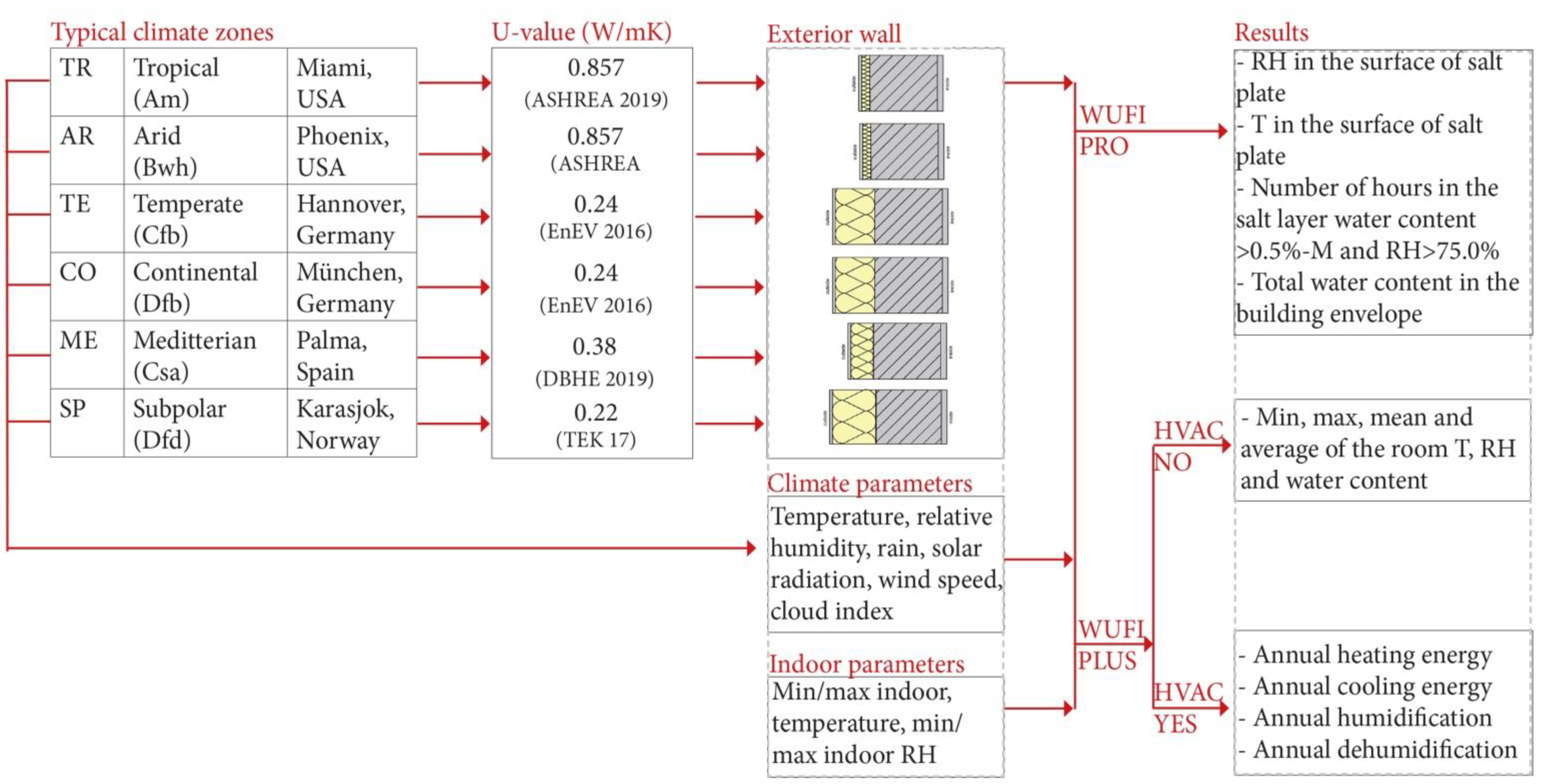
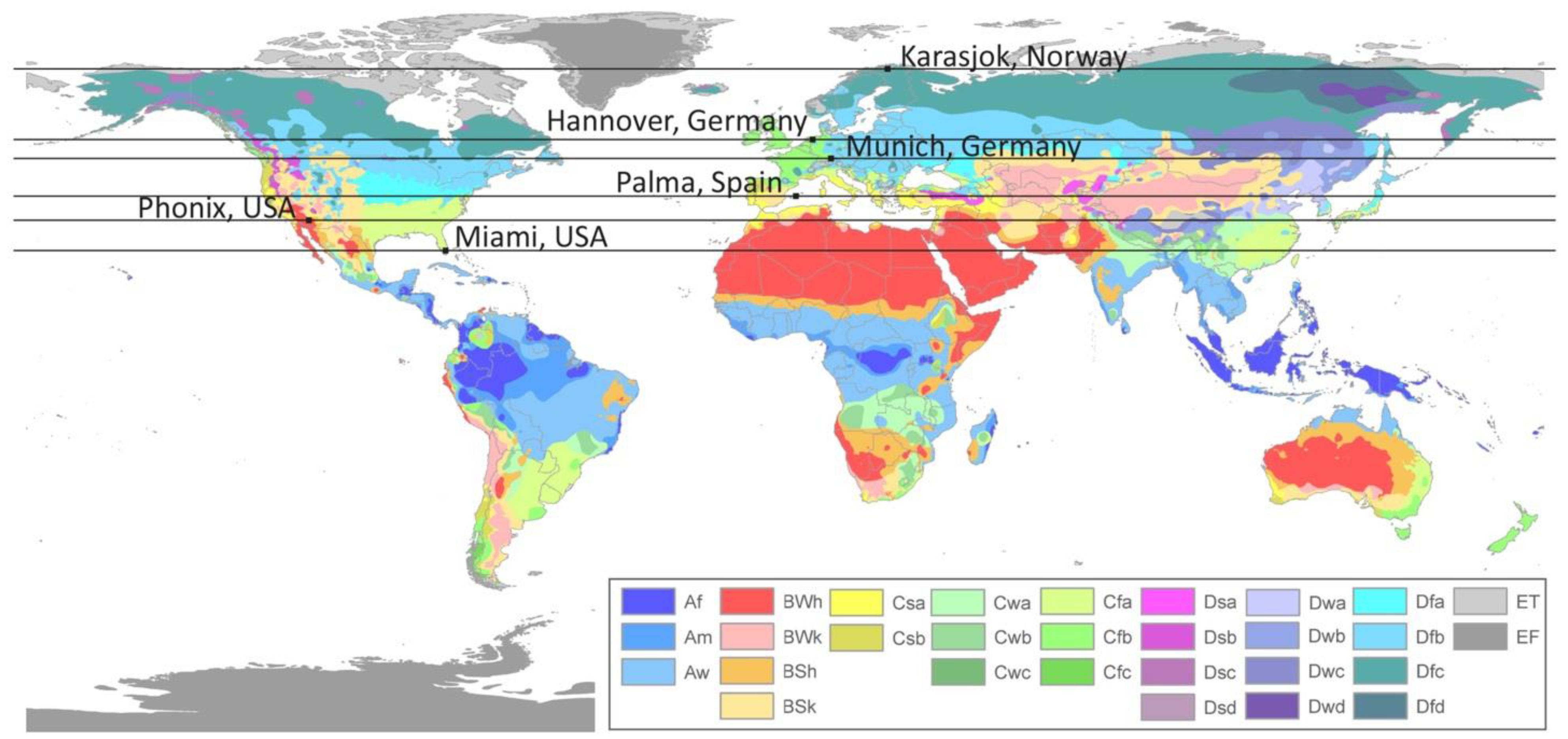



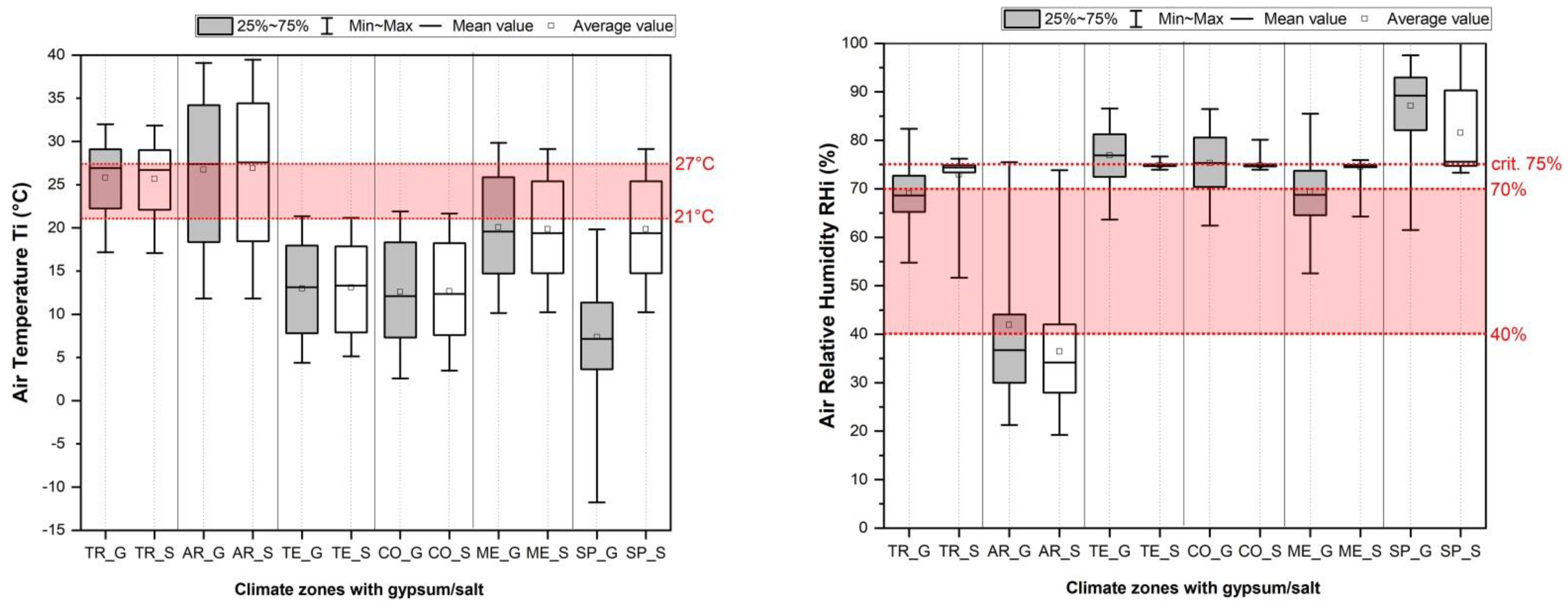

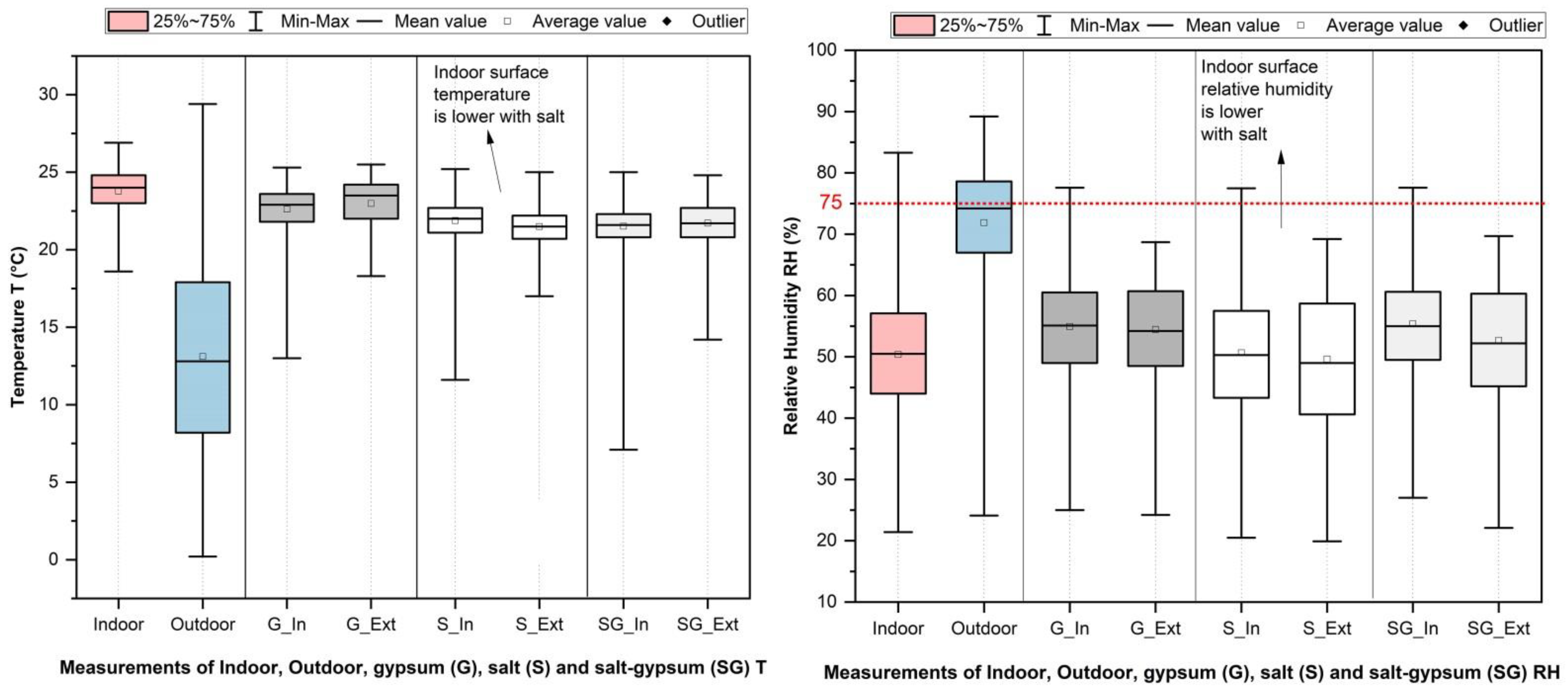
| Climate Zones—Köpper–Geiger Climate Classification | City | Climate | Position (Latitude, Longitude) | U-Value Requirements (W/m2K) | |
|---|---|---|---|---|---|
| TR | Tropical (Am) | Miami, USA | Monsoon | 25.80° N 80.27° W | 0.857 (ASHREA 2019) |
| AR | Arid (Bwh) | Phoenix, USA | Dessert, hot arid | 33.43° N 112.02° W | 0.857 (ASHREA 2019) |
| TE | Temperate (Cfb) | Hannover, Germany | Humid and warm summer | 52.37° N 9.37° E | 0.24 (EnEV 2016) |
| CO | Continental (Dfb) | Munich, Germany | Fully humid, cool summer | 48.13° N 11.72° E | 0.24 (EnEV 2016) |
| ME | Meditterian (Csa) | Palma, Spain | Dry summer, hot summer | 39.56° N 2.65° E | 0.38 (DBHE 2019) |
| SP | Subpolar (Dfd) | Karasjok, Norway | Fully humid cold summer | 69.47° N 25.49° E | 0.22 (TEK 17) |
| WUFI®Pro | WUFI®Plus | |
|---|---|---|
| Outdoor condition (weather data) | Real weather data from the WUFI®Pro/Plus programme | Real weather data from the WUFI®Pro/Plus programme |
| Indoor condition | USA: ASHRAE 160 Europe: EN 15026, DIN 4108, WTA 6-2 | USA: ASHRAE 160 Europe: EN 15026, DIN 4108, WTA 6-2 |
| Component (wall/room) | Thermal envelope | Room (3 m × 3 m × 3 m) |
| Calculation Period, Profiles | 3 Years (time steps: 1 h) | 1 year (time steps: 1 h) |
| Orientation | Wall component is oriented to north (the lowest solar radiation) | No windows to evaluate the influence of the climate zones and construction |
| Inclination | 90° | 90° |
| Initial moisture and temperature in construction component | RH = 70.0% T = 20 °C | RH = 70.0% T = 20 °C |
| Driving Rain Coefficients | 0.07 | 0.07 |
| Monitor Position | Material surface | In a room |
| Number of occupants | 1 person per room | 1 person per room |
| Office indoor heat and moisture load | Standard program input | Convective heat: 33.3 W Radiant heat: 25.2 W, Moisture 17.55 g/h, CO2: 20.79 g/h Human activity: 1.2 met Air velocity: 0.1 m/s |
| Clothing | Standard program input | 0.7 clo |
| Occupancy Period | Standard program input | 7.00–18.00 |
| Energy system | Only heating Depending on the climate zone (norms: EN 15026, DIN 4108, WTA 6-2, ASHRAE 160) | HVAC on: Indoor air temperature 21–27 °C RH 40.0–70.0% Max CO2: 3000 ppmv Air exchange: 0.6 h−1 Heating, cooling, humidification, and dehumidification calculated HVAC off |
| Construction from Outside to Inside (cm) | |||||||
|---|---|---|---|---|---|---|---|
| U-Value (W/m2K) | Mineral Plaster | Mineral Insulation Board | Solid Brick Masonry | Gypsum Plaster | Salt | ||
| Wall 1: Tropical (TR) and arid (AR) climate zone | 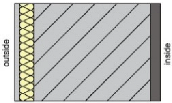 | 0.72 (gypsum) | 1.0 | 3.0 | 24.0 | 2.0 | |
| 0.77 (salt) | 1.0 | 3.0 | 24.0 | 2.0 | |||
| Wall 2: Temperate (TE) and continental (CO) climate zone | 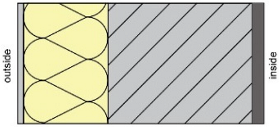 | 0.23 (gypsum) | 1.0 | 14.0 | 24.0 | 2.0 | |
| 0.24 (salt) | 1.0 | 14.0 | 24.0 | 2.0 | |||
| Wall 3: Mediterranean (ME) climate zone |  | 0.35 (gypsum) | 1.0 | 9.0 | 24.0 | 2.0 | |
| 0.35 (salt) | 1.0 | 9.0 | 24.0 | 2.0 | |||
| Wall 4: subpolar (SP) climate zone | 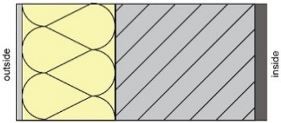 | 0.21 (gypsum) | 1.0 | 16.0 | 24.0 | 2.0 | |
| 0.22 (salt) | 1.0 | 16.0 | 24.0 | 2.0 | |||
| Material properties | |||||||
| Bulk density (kg/m3) | 1900 | 15 | 1900 | 850 | 2087 | ||
| Porosity (m3/m3) | 0.24 | 0.95 | 0.24 | 0.65 | 0.04 | ||
| Specific Heat Capacity (J/kgK) | 850 | 1500 | 850 | 850 | 850 | ||
| Water Vapour Diffusion Resistance Factor (−) | 25 | 30 | 10 | 8.3 | 7836 | ||
| Thermal conductivity (W/mK) | 0.8 | 0.04 | 0.6 | 0.2 | 2.65 | ||
| Typical Build-In Moisture (kg/m3) | 210 | 44.8 | 100 | 400 | 999 | ||
| Sensors | Accuracy Ranges |
|---|---|
| testo 176 H1—Temperature and humidity data logger (data logger for sensors on the test materials) | ±0.2 °C (−20 to +70 °C) ±1 Digit ±0.4 °C (Remaining Range) ±1 Digit dependent on probe selected (0.0 to 100.0% RH) |
| Thin humidity/temperature probe with cable (sensors on the test materials) | ±0.2 °C at 0 to +40 °C ±2.0% RH at +25 °C (2.0 to +98.0% RH) ±0.08% RH/K (k = 1), long-term stability: ±1.0% RH/year |
| testo 175 H1—Temperature and humidity data logger (exterior and interior measurements) | ±0.4 °C (−20 to +55 °C) ±1 Digit at −20 to +55 °C ±2.0% RH (2.0 to 98.0%) at +25 °C ±0.03% RH/K ±1 Digit <±1.0% RH/year drift at +25 °C |
| TR_G | TR_S | AR_G | AR_S | CO_G | CO_S | TE_G | TE_S | ME_G | ME_S | SP_G | SP_S | |
|---|---|---|---|---|---|---|---|---|---|---|---|---|
| Relative Humidity, Surface (%) | ||||||||||||
| Min | 43.85 | 42.68 | 17.58 | 17.38 | 36.95 | 36.60 | 36.94 | 36.62 | 47.19 | 46.95 | 36.61 | 36.31 |
| Max | 89.02 | 99.61 | 71.53 | 73.50 | 68.64 | 70.77 | 68.11 | 69.65 | 74.53 | 76.11 | 66.68 | 68.30 |
| Ave | 69.81 | 70.17 | 38.92 | 39.02 | 54.27 | 54.27 | 54.80 | 54.84 | 61.04 | 61.08 | 46.37 | 46.42 |
| Mean | 70.76 | 70.92 | 38.80 | 38.83 | 53.80 | 53.74 | 54.34 | 54.32 | 62.73 | 62.91 | 45.81 | 45.77 |
| Water Content, Surface (kg/m3) | ||||||||||||
| Min | 3.95 | 4.95 | 1.33 | 1.66 | 2.82 | 3.64 | 2.91 | 3.79 | 3.69 | 4.29 | 2.72 | 3.07 |
| Max | 6.83 | 36.52 | 5.23 | 5.40 | 5.32 | 5.41 | 5.40 | 5.42 | 5.69 | 41.01 | 5.19 | 5.38 |
| Ave | 5.57 | 6.47 | 2.84 | 2.77 | 4.14 | 4.25 | 4.18 | 4.33 | 4.81 | 4.69 | 3.45 | 3.83 |
| Mean | 5.63 | 5.12 | 2.85 | 2.59 | 4.10 | 4.25 | 4.13 | 4.31 | 4.97 | 4.68 | 3.34 | 3.81 |
| Salt (Water Content > 0.5 kg/m3 and RH > 75.0%), Gypsum (T = 5–40 °C and RH > 80.0%) (1st year, 2nd year, 3rd year) | ||||||||||||
| Hours | 19.0, 0.0, 0.0 | 414.0, 196.0, 402.0 | 0.0, 0.0, 0.0 | 0.0, 0.0, 0.0 | 0.0, 0.0, 0.0 | 0.0, 0.0, 0.0 | 0.0, 0.0, 0.0 | 0.0, 0.0, 0.0 | 0.0, 0.0, 0.0 | 2.0, 0.0, 0.0 | 0.0, 0.0, 0.0 | 0.0, 0.0, 0.0 |
| Temperature, Surface Layer (°C) | ||||||||||||
| Min | 20.51 | 19.95 | 19.71 | 19.56 | 19.05 | 19.03 | 19.18 | 19.16 | 19.24 | 19.20 | 18.54 | 18.50 |
| Max | 32.43 | 32.40 | 41.47 | 41.43 | 24.88 | 24.88 | 24.82 | 24.83 | 25.20 | 25.23 | 23.99 | 23.95 |
| Ave | 27.73 | 27.68 | 28.20 | 28.17 | 20.78 | 20.77 | 20.77 | 20.75 | 22.56 | 22.55 | 19.66 | 19.65 |
| Mean | 27.86 | 27.79 | 28.14 | 28.13 | 19.65 | 19.64 | 19.70 | 19.69 | 22.88 | 22.85 | 19.43 | 19.42 |
| Water content, whole construction (kg/m2) | ||||||||||||
| Min | 2.81 | 2.36 | 0.39 | 0.38 | 1.68 | 1.51 | 1.78 | 1.59 | 2.15 | 1.95 | 1.65 | 1.34 |
| Max | 3.58 | 3.83 | 3.17 | 3.16 | 3.47 | 3.63 | 3.33 | 3.49 | 3.52 | 3.95 | 3.30 | 3.56 |
| Ave | 3.10 | 2.71 | 0.98 | 0.92 | 2.20 | 2.32 | 2.26 | 2.43 | 2.53 | 2.53 | 2.08 | 2.42 |
| Mean | 3.11 | 2.65 | 0.98 | 0.73 | 2.16 | 2.19 | 2.23 | 2.31 | 2.47 | 2.46 | 1.97 | 2.51 |
| S_In RH | S_In T | S_Ext RH | S_Ext T | G_In RH | G_In T | G_Ext RH | G_Ext T | SG_In RH | SG_In T | SG_Ext RH | SG_In T | |
|---|---|---|---|---|---|---|---|---|---|---|---|---|
| Min | 33.46 | 18.90 | 33.31 | 18.40 | 39.93 | 18.91 | 41.24 | 18.57 | 41.97 | 18.84 | 3817 | 18.57 |
| Max | 70.86 | 24.99 | 68.11 | 24.76 | 72.72 | 25.06 | 68.25 | 24.91 | 73.21 | 24.82 | 69.00 | 24.65 |
| Ave | 50.72 | 21.90 | 49.70 | 21.52 | 55.01 | 22.63 | 54.52 | 23.00 | 55.42 | 21.54 | 52.74 | 21.74 |
| Mean | 50.01 | 21.88 | 49.43 | 21.46 | 54.27 | 22.88 | 53.46 | 23.52 | 54.21 | 21.45 | 52.71 | 21.69 |
Publisher’s Note: MDPI stays neutral with regard to jurisdictional claims in published maps and institutional affiliations. |
© 2022 by the authors. Licensee MDPI, Basel, Switzerland. This article is an open access article distributed under the terms and conditions of the Creative Commons Attribution (CC BY) license (https://creativecommons.org/licenses/by/4.0/).
Share and Cite
Pungercar, V.; Musso, F. Hygrothermal Performance of Salt (NaCl) for Internal Surface Applications in the Building Envelope. Materials 2022, 15, 3266. https://doi.org/10.3390/ma15093266
Pungercar V, Musso F. Hygrothermal Performance of Salt (NaCl) for Internal Surface Applications in the Building Envelope. Materials. 2022; 15(9):3266. https://doi.org/10.3390/ma15093266
Chicago/Turabian StylePungercar, Vesna, and Florian Musso. 2022. "Hygrothermal Performance of Salt (NaCl) for Internal Surface Applications in the Building Envelope" Materials 15, no. 9: 3266. https://doi.org/10.3390/ma15093266
APA StylePungercar, V., & Musso, F. (2022). Hygrothermal Performance of Salt (NaCl) for Internal Surface Applications in the Building Envelope. Materials, 15(9), 3266. https://doi.org/10.3390/ma15093266






